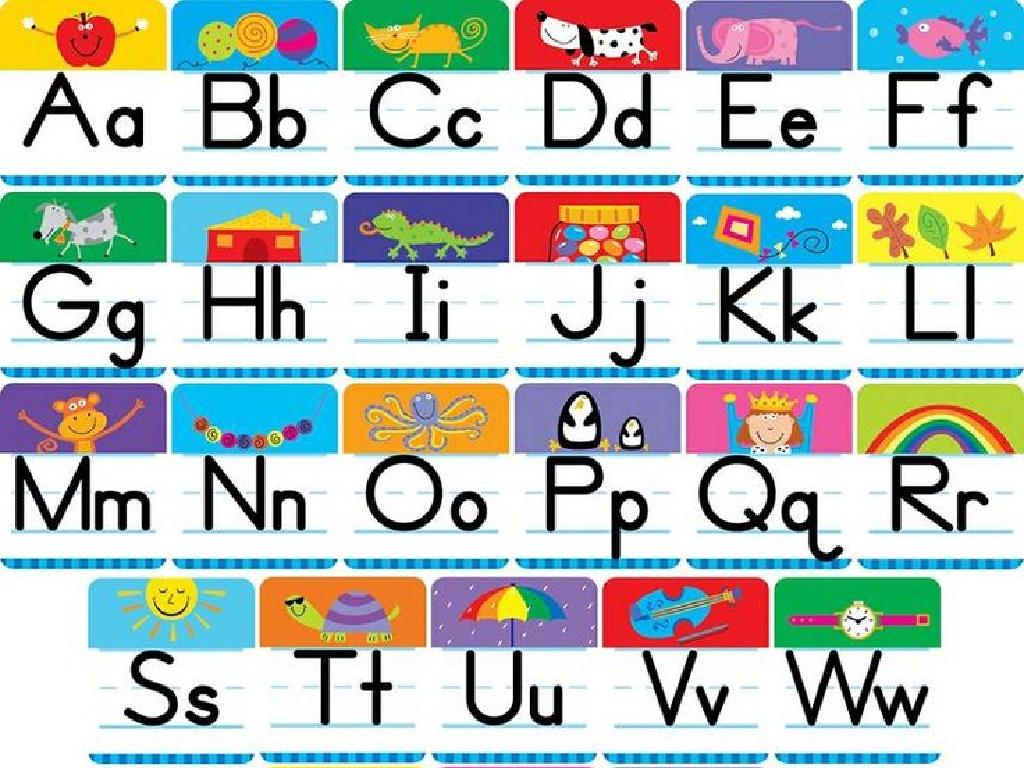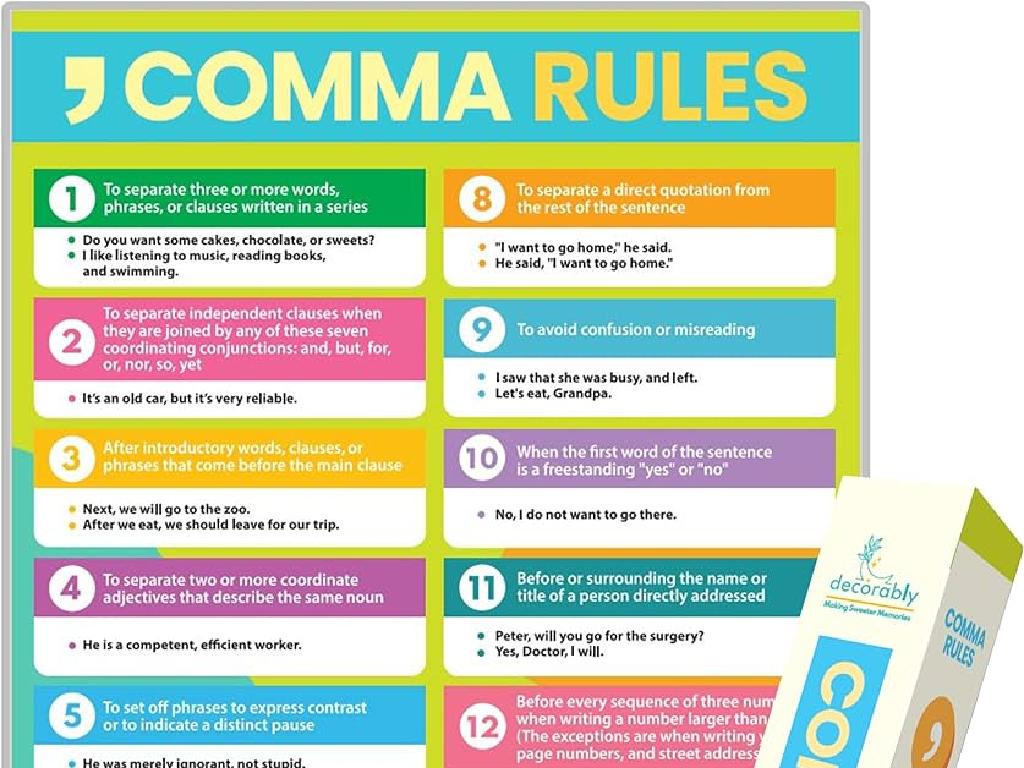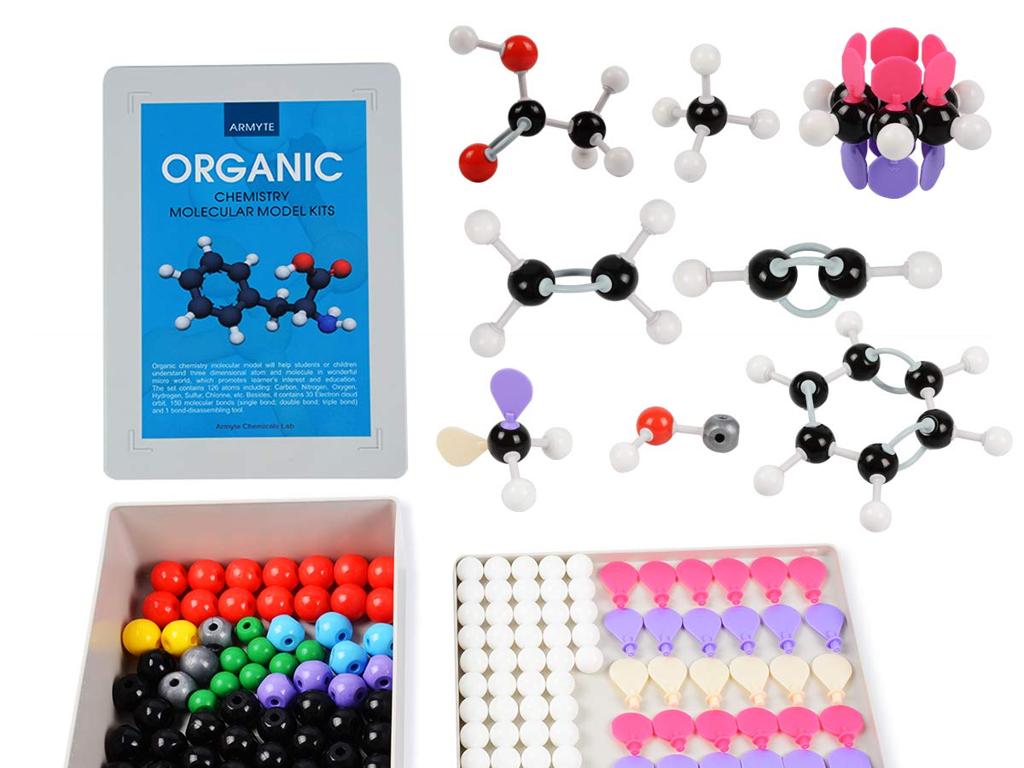Relationship Between Area And Perimeter: Find The Area
Subject: Math
Grade: Third grade
Topic: Perimeter
Please LOG IN to download the presentation. Access is available to registered users only.
View More Content
Exploring Perimeter and Area
– Understanding shapes and spaces
– Shapes like squares, rectangles have area and perimeter
– Perimeter: The outline of a shape
– Add up all the sides to find the perimeter
– Area: Space inside the shape
– Multiply length by width for rectangles to find area
– Relationship between area and perimeter
– Sometimes changing one can affect the other
|
This slide introduces the basic concepts of perimeter and area, which are fundamental in understanding geometry. Start by discussing different shapes and the spaces they occupy. Explain that the perimeter is the total length of all the sides of a shape, and it’s like walking around the shape’s edge. For area, help students visualize the space inside the shape, which can be filled with tiles or paint. Use simple examples like a rectangle’s length and width to demonstrate how to calculate area. Highlight that while perimeter and area are related, they measure different things and changing the size of a shape can affect both its perimeter and area. Encourage students to think about how a fence (perimeter) and a garden (area) are different but related.
Exploring Perimeter: Finding the Area
– Perimeter: border length of a shape
– Think of it as the fence around a yard
– Measuring a shape’s sides
– Use a ruler to measure each side
– Add all sides for the perimeter
– Add lengths of all sides together
– Relationship between area and perimeter
– Area is the space inside, different from perimeter
|
This slide introduces the concept of perimeter as a foundational element in understanding the relationship between area and perimeter. Begin by explaining that the perimeter is like the length of a fence that surrounds a yard, which helps students visualize the concept. Demonstrate how to measure the sides of different shapes using a ruler, emphasizing the importance of accurate measurement. Guide students through the process of adding all the side lengths to find the total perimeter. Highlight that while perimeter is the border, area is the space inside the shape, and they are related but different concepts. Prepare to show examples of how changing the perimeter can affect the area and vice versa in the following lessons.
Exploring Area: Space Inside Shapes
– Area: space inside a shape
– Measure area with square units
– Like tiles on a floor, we use squares to measure how much space is inside.
– Count squares to find rectangle area
– Each square inside a rectangle or square counts as one unit of area.
– Practice with square shapes too
– Squares are special rectangles; let’s count their squares together!
|
This slide introduces the concept of area as the amount of space inside a two-dimensional shape. Emphasize that area is measured in square units, which can be thought of as little tiles that cover the surface without gaps or overlaps. Use visual aids like grid paper to help students count the number of squares inside rectangles and squares. Encourage them to understand that for squares, since all sides are equal, they can also find the area by multiplying the length of one side by itself. Prepare to have students practice with different sized rectangles and squares to reinforce the concept.
Exploring Area and Perimeter Together
– Perimeter vs. Area: What’s the difference?
– Perimeter is the border length. Area is the space inside.
– Real-life uses of perimeter and area
– Perimeter: fencing a garden. Area: planting seeds.
– Same perimeter, different areas?
– Yes, different shapes can share a perimeter but have different areas.
– Activity: Find areas of shapes
|
This slide introduces the concepts of perimeter and area, highlighting their differences and applications. Perimeter is the total distance around the edge of a shape, while area measures the space inside the shape. Provide real-world examples such as using perimeter to determine the length of fence needed for a garden and using area to decide how much seed is required for planting. Discuss how shapes can have the same perimeter but different areas, which can be a fun and engaging activity for the students. Have them draw different shapes with the same perimeter and calculate the area for each, fostering a deeper understanding of the relationship between the two measurements.
Let’s Calculate: Area vs. Perimeter
– Find rectangle’s perimeter
– Add up all sides: length + length + width + width
– Calculate rectangle’s area
– Multiply length by width: length x width
– Compare perimeter and area
– Does a larger perimeter mean a larger area?
– Observations on relationship
– Notice patterns and discuss findings
|
This slide is aimed at helping third-grade students understand the relationship between the perimeter and area of a rectangle. Start by explaining how to find the perimeter by adding up the lengths of all the sides. Then, show how to calculate the area by multiplying the length by the width. Encourage students to compare the two measurements for the same rectangle and discuss their observations. Do they always increase together? Can a shape with a larger perimeter have a smaller area than another with a smaller perimeter? Use examples to illustrate these concepts. This will help students grasp that while perimeter and area are related, they are not directly proportional.
Real-Life Application: Area & Perimeter
– Why area & perimeter matter
– Example: Garden planning
– Imagine planning where to plant flowers or how much fencing you need
– Activity: Design a garden
– Use graph paper to draw a garden & calculate its area and perimeter
– Understanding space usage
– Knowing area helps decide how much space for plants; perimeter tells fence length
|
This slide aims to show students the practical importance of understanding area and perimeter through the example of planning a garden. Explain how area helps us determine how much space we have for planting, while perimeter lets us know how much material we need for fencing. For the activity, provide students with graph paper and ask them to draw their own garden plans, calculating both the area and perimeter. This hands-on activity will help solidify the concepts and demonstrate their usefulness in everyday life. Offer guidance on how to use the graph paper to represent space accurately and how to perform the calculations. Prepare to discuss different shapes they might use for their gardens and how that affects the calculations.
Class Activity: Create Your Park!
– Receive a blank park map
– Place features using area & perimeter
– Consider the space (area) and fence length (perimeter) for each feature
– Share your park design
– Explain your design choices
– Tell us why you put each item where you did
|
In this engaging activity, students will apply their knowledge of area and perimeter to design their own park. Provide each student with a blank map and a set of cut-out park features. They must decide where to place each feature by considering both the area it will occupy and the perimeter that defines it. For example, a larger playground will need more space (area) and a longer fence (perimeter). After placing the features, students will share their designs with the class and explain the reasoning behind their choices, reinforcing their understanding of the concepts. Possible variations for different students could include varying the shapes and sizes of the features, or setting specific requirements for the area and perimeter of certain park areas.
Wrapping Up: Area and Perimeter
– Recap: Perimeter and Area
– Perimeter is the border length. Area is space inside.
– Importance of these measurements
– Helps in real life, like fencing a yard or laying carpet.
– Quick quiz time!
– Test your knowledge with a fun quiz.
– Review answers together
– Let’s discuss the quiz answers as a class.
|
As we conclude today’s lesson, it’s important to review the key concepts to ensure understanding. Start by recapping the definitions of perimeter and area, using simple terms and examples. Explain how these measurements are used in everyday life, such as determining the amount of paint needed for a wall or the size of a garden. Conduct a quick, interactive quiz to engage the students and assess their grasp of the topic. After the quiz, review the answers together, providing immediate feedback and clarification. This will help solidify the students’ knowledge and prepare them for applying these concepts in real-world situations.





